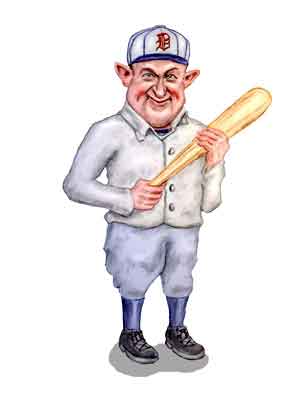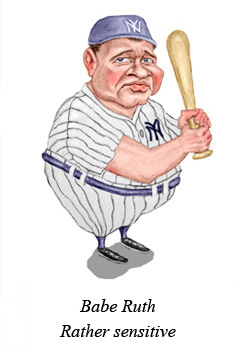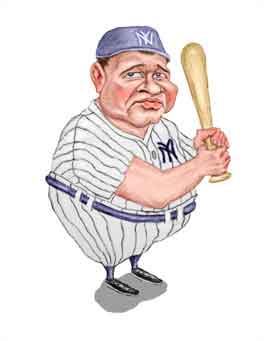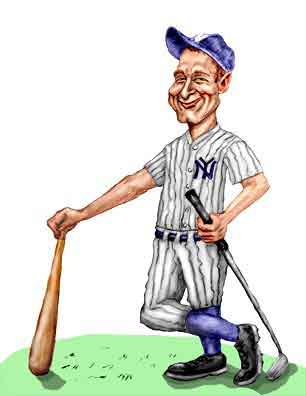Ty Cobb
The Ogre of the Dead Ball Era?

Tyrus Raymond Cobb
Maybe not so bad.
Tyrus Raymond Cobb was certainly the greatest player in the "dead ball era", that is the early years before George Herman "Babe" Ruth started swatting out homers at four to five times the rate previous sluggers had managed. Of course, Ty - ten years Babe's senior - didn't think much of the Babe, who was an upstart scion from lower class Baltimore saloon keepers. Babe's mom had died young, and his dad was killed in a fight with a rowdy customer.
But because of Babe's "incorrigible" behavior as a kid (he drank, smoked, and stole anything he could), his parents placed in St. Mary's Industrial School. St. Mary's has been called - with reasonable accuracy - a reform school. Ty on the other hand had come from a good family. His dad was a college graduate, a schoolteacher, and had been a Georgia state senator. So you'd expect Ty's life to be far less traumatic than Babe's.
Weeeeeelllllll, not quite. On August 8, 1905, Ty's dad told his wife he was going out of town for a few days. He was after all a man of many responsibilities, and in the pre-Internet days long distance business had to be conducted in person. By then Ty no longer lived at home and had already established himself as a first rate minor league player. In fact, he had just been called up to the majors and shortly would be leaving for Detroit. On this night, Ty's younger siblings were staying with friends, and so Mrs. Cobb was alone.
Soon after Mrs. Cobb had retired to her room, she heard the sound of someone trying to come into the house. Now in a small Georgia community in 1905 that could easily have been just a neighbor paying a visit. In rural America it was (and in some places still is) customary for friends to enter a friend's house with perhaps a friendly shout of greeting. But on that night the - ah - visitor was trying get in through her bedroom window - and she was on the second floor.
So Mrs Cobb deduced this was not someone coming to pay a friendly social call. Frightened, she grabbed a double barrel shotgun and fired twice at the shadowy form. The prowler, who was armed with a pistol, fell dead. Mrs. Cobb was safe.
There was a slight problem. The "prowler", it turned out, was Mr. Cobb who had come back home unannounced and unexpected.
Oops.
Exactly what had been going on has never been cleared up to everyone's satisfaction. The prevailing theory is that Mr. Cobb had begun to wonder if his wife was keeping to strict Georgia family values. One way to find out was to simply catch Mrs. Cobb in mid-dalliance. Hence the "business trip" and the surreptitious return home with the unfortunate but nonetheless accidental outcome.
Of course, there is the possibility that Mr. Cobb did catch his wife - ah - keeping company, and it was Mrs. Cobb's hypothetical and as yet unidentified boyfriend who was the one who actually pulled the trigger. But whatever the circumstances, the local authorities decided they couldn't simply write the incident off as sad misadventure. So Mrs. Cobb was arrested and put on trial. Ty attended the proceedings and supported his mother, who was acquitted.
Naturally such an episode could hardly have left the relatively young Ty unaffected, particularly since Mr. Cobb had been lukewarm at best regarding Ty's ambitions to be a professional ball player. Finally, though, when it was clear Ty had the stuff needed to make it in the pros - and particularly after Mr. Cobb's friends began slapping him on the back remarking on how great Ty was doing in the minors - Mr. Cobb had finally accepted his son's ambition. But the knowledge that his dad never quite approved of his career pushed Ty to work even harder than ever. He later told sports writer Al Stump that the near frenzied drive he had to excel was because his dad never got a chance to see him play in the majors.
Ty started his major league career in 1905 with the Detroit Tigers. He was a player until 1921 when be came player-manager. Ty had always been a master of the inside-the-ballpark strategies where you had to score without knocking the ball over the fence. Now Ty claimed he could have been a slugger if he had wanted to, but simply preferred the scientific approach. Once he did hit three homers in one game although his lifetime home run total - 117 - is pretty paltry by today's standards.
Ty remained with Detroit until 1926 until he went to the Philadelphia Athletics. He retired in 1928. At that time he held the record in stolen bases (892), stealing homeplate (54), most singles (3035), total bases (5854), and highest vote percentage when elected to the Hall of Fame (98.23%). Of course, we're cheating a little on the last point because Ty was in the first class elected at Cooperstown. But he held the #1 percentage there until Tom Seaver pushed him down in 1992. Even today Ty holds the record for the highest batting average (.366) and runs scored (2245). He held the record for hits at 4191 until Pete Rose's tally passed him in 1985.


Babe Ruth
Rather sensitive.
Much has been written about how mean and ornery Ty was. We read he routinely spiked players, fought a groundskeeper and choked the man's wife, beat up an amputee for heckling, and even killed a man. His teammates, we learn, hated him so much that when Ty died only three showed up for his funeral.
It is true that Ty did not get off to a smooth start with some of the other Detroit players. The worst time was his second season, and he was mercilessly razzed by some of the veterans who saw him as a threat. The harassment became so bad that Ty took to carrying a pistol. So its understandable that Ty adopted a hard-nose and even belligerent persona within the team. Rip Collins - who played with Ty from 1920 to 1926 said Ty, particularly as manager, could take a lot of fun out of the game. "I hated to work for him," Rip said, "and I am frank to say I wouldn't like to work for him now." But Rip did add it was possible to recognize Ty's good points - if you played on a different ball club.
During games Ty became the master of the taunt and would use any knowledge of his opponents to enhance the effect of a good gibe. The story had gotten around that Babe Ruth never changed his underwear. So when Detroit played the Yankees, Ty would make sure he would walk by Babe and casually ask his teammates, "You fellows smell something?" He would then look up in feigned surprise and say, "Oh, hello, Babe!" Babe - somewhat sensitive to insults - would usually respond with a string of obscenities.
Even today you do have the bad boys in sports, and you have to remember that in Ty's day baseball was not a genteel sport played by genteel men. Although some players had attended college - Lou Gehrig attended Ivy League's Columbia - many players had been farmers, laborers, and miners who had the ability, coordination, and drive to make professional baseball a way out of poverty. Taunting your opponents was an accepted part of the strategy, and if such behavior led to physical confrontations and even riots, well, that was simply part of the game.

Lou Gehrig
From the Ivy League
Ty's own reaction to insults - not always the best - has been linked to his much commented-on racism. However, by the early 1950's he was fully supporting the integration of sports. Still it's hard to deny when he was an active player, he fit the mold of an unreconstructed Southerner. It was in 1912 when Ty severely beat a man who had lost his hands for heckling. His ferocious response to the taunts was less due to the heckling per se than the fact the man's taunt insinuated that one side of Ty's family hearkened back to sub-Saharan Africa. Ty climbed into the stands and very nearly killed the man. When the crowd yelled for Ty to stop and pointed out that the man had no hands, Ty shouted back. "I don't care if he's got no feet!"
It's quite proper that sports writers and historians step back from time to time and reevaluate whether the picture of our heroes stand up under scrutiny. But we still have to say that as good - even iconic - an athlete as Ty was, he had emotional and behavioral problems even by the standards of his time. True, he could be generous to those he liked and gracious and encouraging to young athletes. He donated hundreds of thousands of dollars for charities - including money for hospitals and the health care of black Americans. On the other hand he suffered from what are now politely referred to as anger management problems which led him to behavior which today would be criminal. After all a father who is disappointed in a son's performance in college should not go to the school and beat the young man with a whip. In his last years, in failing health which possibly affected his mental stability, Ty was still unpredictable with spells of near maniacal and even dangerous behavior.
It's also not true only a few people showed up for Ty's funeral in 1961. There were over a hundred, and since it was a private service not too much should be read into who showed up and who didn't. The representatives from baseball were few in number, yes, the usual number cited being three or four. But by then most of Ty's friends from his playing days - and he did have friends - were dead and gone.
References
Cobb - A Biography: The Life and Times of the Meanest Man Who Ever Played Baseball, Al Stump, Algonquin Books (1994). Al spent considerable time with Ty in the old player's later years. He found that dealing with Ty could be a trying and at times terrifying experience, such as when Ty made a frenzied drive through snow covered mountain roads so he could gamble at a casino. But Ty Cobb in the 1950's and '60's was not necessarily the Ty Cobb from 1905 to 1949. Ty, like everyone else changed, sometimes for the better, sometimes for the worse. But in fairness we should mention that Al's story where he says there is evidence Ty did indeed kill a man on the streets of Detroit is less believed than formerly.
Baseball Guru, Bill Burgess, http://baseballguru.com/bburgess/ Some very good information and analysis of Ty Cobb's playing and character showing that although Ty was emotional, driven, and highly competitive, he was not consistently the terrifying ogre he has been pictured. Ty certainly could be an ogre, but at times he was a nice guy.
"Ty Cobb's Ugliest Scandal", James Ray, Suite 101, http://baseball.suite101.com/article.cfm/ty_cobbs_ugliest_scandal. An account of Ty beating the man who heckled him with a racial taunt. Not acceptable behavior for professional athlete (or anyone else).
"The Sweet Side of Ty Cobb", Kevin Mitchell, The Saskatoon Star-Phoenix, Sunday, December 26, 2004. A story about Ty helping a young baseball aspirant. You wouldn't know it was the same man who - as pointed out above - mercilessly beat a handicapped man. Available at the time of this posting at "http://www.spirit-wrestlers.com/excerpts/2004_Ty_Cobb.html.
Ty Cobb Museum, http://www.tycobbmuseum.org/index.shtml.htm. A good place for quick information on Ty.